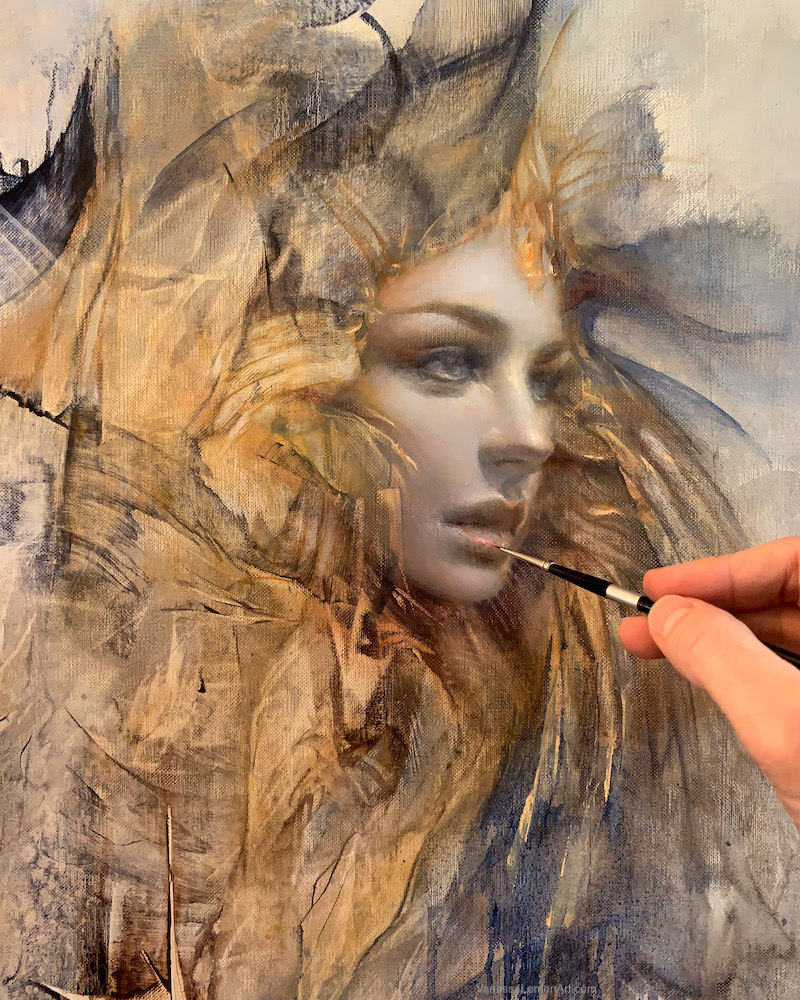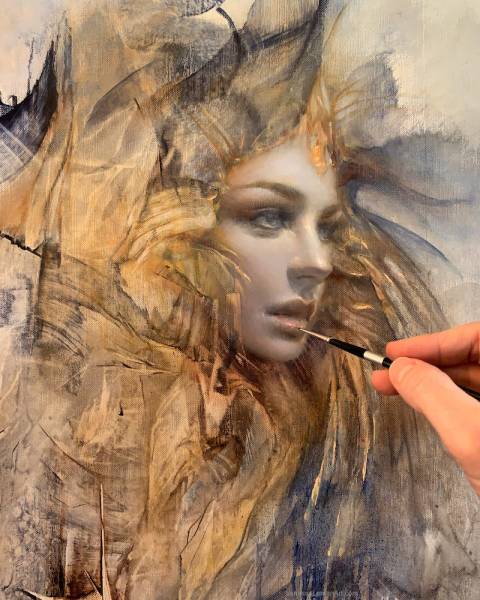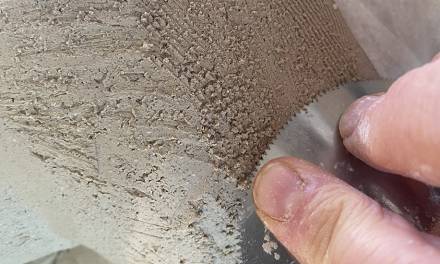I’m sharing another video of my painting process here again today. This one is a new painting titled “Leona” and is still in progress. In this video (Part 1 of 2), you will see some areas of nearly full progress and how I tend to build a painting from start to finish. The painting is oil on (canvas adhered to) ACM panel, 18×24”. The painting is painted from imagination. I will share Part 2 sometime in the near future when the painting is finished.
Here is a recap and notes for the video:
I started with abstract marks on an ACM panel, having fun with some big strokes and lots of movement and experimentation. This panel is an Artefex AllinPanel 537 which is an oil primed panel – 537 is the fine weave linen canvas adhered to the ACM substrate. The initial marks were made with a basic chip brush, which is one of my most-used brushes for initially applying paint and beginning stage mark-making. In this stage, I discovered that my mixture of paint and linseed/gamsol was a bit too thin and “watery” and tended to drip more than I had expected, so I used some rags and paper towels as tools that could produce softened marks while also mopping up some of the excess thinned paint. Then I sort of started over with those marks underneath, and a mix of paint that was less thinned down.
The shaper tools are what I used around 00:10 to carve into the paint on the surface. These are called paint shaper tools, and I find they’re great for pick-out. I personally use them less for shaping paint and more for picking out. Depending on tilt and pressure as well as absorbency of surface and whether the paint is thick or has something added to thin it, you can get a lot of different marks from these paint shapers.
At 00:22, I used a shower squeegee as well for picking out and making larger marks. This shower squeegee has a silicone blade which I find works well for pickout compared to the plastic blades in some other squeegees. I’ve tried all sorts of squeegees and they all vary slightly. I’ve also tried windshield wipers and car window squeegees and those work well too for larger pickout marks like this shower squeegee does.
At 00:24, the kitchen spatula I use (with the smiley face here in this video) does essentially the same thing. It’s silicone and works great for pickout and various marks depending on tilt and pressure. The paint at this stage was still very wet in some areas and was dripping through the marks I made at times as I’d turn the panel in different directions to vary the direction of the marks and forms that developed. I find all of this to be added experimentation and just treat it as new avenues that lead to discovering new ways of working. At this stage, I also tend to make marks with the panel laying flat, but in this video, I worked on my easel with the painting upright, turning it occasionally for variation.
At around 00:30, I used a silicone comb that makes rake-like stripes. These can be found on amazon and/or at art supply stores. I prefer the soft (rather than firm) silicone, and they are called different things depending on the brand. If searching amazon, search for Xiem Tools texture combs (soft). The one I use in this video is not this brand, but this Xiem Tools comb is the closest to it that I’ve found and works well (the one I use has been discontinued). Other brands for these sorts of tools are Princeton Catalyst tools as well as for standard paint shapers there are a variety that can be found online and in art supply stores (Trekell carries a line of paint shapers, for example) and home improvement stores and in craft stores in art/craft supplies as well as some in cake decorating (however, beware that cake decorating tools are often harder plastic and don’t function quite the same). The other avenues for these sorts of tools are kitchen tools like spatulas, potters ribs used for sculpting, and shower squeegees or car window wipers. You can always use the standard straight-edged tools and cut your own notches into them as well, which I also do and that works well. I’ve tried and used all of the above and have enjoyed all the various marks that can be made with them. Well, that was a lot of info for about 3 seconds of this video. haha. But I get asked so often about those particular comb/striping tools especially, so I thought I’d share a bit more about them here.
From about 00:33, I built the face up from abstract marks to rendered form using various small-to-medium sized brushes and at first only white in varying degress of opacity/transparency. Both bristles and sables were used for this, and then a small round was used for making small strokes/marks and details around the eye and other features.
Around 00:47, I used a large sable filbert that is very similar to using a mop brush to apply while simultaneously softening the area of gold tones around the head. I used this same method to apply color to the initial white rendered areas of the forms of the face.
Around 00:49, I showed details of marks made in and around the face. Much of the marks made on the edges of the face and in the headdress/hair were made with paint shapers of various sizes and purposes (combs as well as straight edges of spatulas etc).
I then added some subtle additions of paint for halftones framing the face with a filbert, then more details in the eyes with a small round again, and then some softening on the edge of the nose with a small mop.
A brief pan across this painting at this still-in-progress stage closes this video. I look forward to sharing the development of this painting in a future post here on Muddy Colors. If you’d like to view more posts about my process and the tools I use, you can find my other posts here.
I hope some of this info helps and I hope you enjoy seeing the videos of a glimpse into my painting process.









Recent Comments